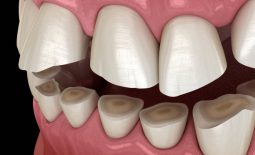How Technology is Transforming Dentistry
The technology we are using today would have been considered futuristic just ten years ago, and science fiction twenty years ago.

I view dentistry as a blend of science and art, and with the care I provide I strive to satisfy both disciplines. Dental school provides a rigorous scientific training to assure that our work is durable, functional, and bio-compatible, while our artistic training drives us toward results that are as unnoticeable as possible. In other words, I strive for restorations that are natural-looking, not attention-grabbing. I want your friends to think “Wow, what a beautiful smile!” not “Wow, look at all that dentistry!”
Almost no other profession seeks to be as ‘invisible’ as the dental profession. Just as you want your restorations to be seamless and harmonious with the rest of your smile, the process of making those restorations is often just as inappreciable. This is where advancements in technology have had their greatest impact, operating behind the scenes to give us results that are more predictable, longer lasting, and more esthetically satisfying than ever before.
Here is a story that represents a typical situation of replacing a missing tooth, demonstrating several of the newest technologies at work in the background: 3D imaging (X-ray), 3D printing, dental implants, digital scanning, and CAD/CAM (Computer Aided Design/Computer Aided Manufacturing).


Dental implants are typically made out of titanium and are about the size of two tic-tacs lying end-to-end. Do they still make tic-tacs? Anyhow, it turns out that the body really likes titanium, so much so that bone will actually bond to it. This was discovered accidentally in 1940 and was termed ‘osseointegration’ by Per-Ingvar Branemark, a Swedish physician who actually placed the first dental implant in 1965. This discovery revolutionized the field orthopedics, paving the way for modern joint replacement components. Today, the vast majority of artificial joints are titanium-based (or cobalt-chromium). Titanium’s impact on dentistry has come along more slowly, but surely as dental implants are gaining acceptance with insurance companies and patients.
You may be wondering, “Today’s implants aren’t made out of the same stuff that was used in the 40’s, are they?” And in fact you’re right, just as we’ve moved on from polyester clothing and avocado green appliances, the implants themselves have evolved over time, both in design and composition. A buzzword you may have heard a lot lately is ceramic. Ceramic cookware, ceramic knives, ceramic watches, and of course ceramic dental crowns. At one time the term ceramic simply referred to mugs, dishes, and vases. Certainly our pans, knives, watches, and crowns aren’t made of the same material, which is basically clay baked in an oven. The distinction is the term porcelain, which generally refers to clay-based items, and the broader category of ceramics.
So what exactly is a ceramic? Ceramics form a rather nebulous category that includes many different materials, but for our purposes a ceramic is a combination of two or more elements that form a crystalline pattern when set and have certain common properties. By comparison, combining two metals together produces an alloy (like copper and zinc form the alloy brass), but modern ceramics are often a combination of a metal, such as titanium, tungsten or silicon, and a non-metal, such as carbon, nitrogen, or oxygen. Ceramics are also typically very hard and brittle. If you hit a metal or metal alloy with a hammer you will leave a dent, hit it harder and you will get a bigger dent. Hitting a ceramic will not leave a dent, but hitting it too hard will cause it to shatter.

In the spectrum of dental implants, pure titanium would be on one end and pure ceramic, such as zirconia, would be on the other. Most implants placed today fall in the middle, with the body of the implant made out of titanium and an outer coating of a ceramic material. The most common coating is hydroxyapatite, which is a ceramic of calcium (metal) and phosphorus (nonmetal). This coating enhances bone adhesion, decreases chances of an allergic reaction, and decreases healing time. These beneficial properties are due to the fact that hydroxyapatite occurs naturally in bone and teeth, and thus is referred to as a bioceramic.
Titanium with a hydroxyapatite coating gives us the best of both worlds, making it the preferred choice for dental implants as well as joint replacement parts and other uses. Pure zirconia implants have the benefit of being white, which may be helpful in situations where the implant may be visible through the gum tissue, such as when they are used to replace front teeth. The disadvantage is that, since they are a ceramic, they can be brittle and prone to fracture. A fractured implant that has already bonded to the bone can present a challenging and expensive situation to rectify.

The implant itself is only one of three components. A final crown must be placed later to fully represent the missing tooth, and between the implant and crown is the third component called an abutment.
Once adequately bonded to the bone, the implant is now ready to have the final crown made. Up until this point the implant has been hidden under the gum tissue, nearly invisible except for a small healing cap. The healing cap is removed and a small post is attached for the digital impression. Our intraoral camera is a wand-like instrument with a lens at the end, we hold it over the implant site and it takes a series of images to generate a 3D representation of the area. The post is removed, the healing cap is replaced, and the 3D ‘impression’ is sent to a dental lab for fabrication of the abutment and crown.

The big day has arrived! Usually without needing any anesthesia, the healing cap is removed and the abutment and crown are attached and checked for proper fit and bite. Our patient is ready to immediately start using the new tooth, and in fact our instructions are to treat it as if it were a natural tooth: brush, floss, chew, smile! With proper care an implant can potentially last the rest of one’s life.
The materials, techniques, and instruments of tomorrow are being developed today. Dental implants will continue to evolve, giving us even easier placement, quicker healing, and more reliable results. Someday we may not even need implants; research is currently being conducted to regrow a new tooth right in the patient’s jaw. Sound like science fiction? Maybe today, but one day it might be science future, and soon after become science fact.
Patrick McGann, DDS


